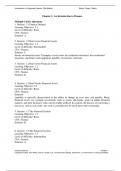Introduction to Corporate Finance, Fifth Edition Booth, Cleary, Rakita
Chapter 1: An Introduction to Finance
Multiple Choice Questions
1. Section: 1.1 Finance Defined
Learning Objective: 1.1
Level of difficulty: Basic
CPA: Finance
Solution: A
2. Section: 1.2 Real versus Financial Assets
Learning Objective: 1.2
Level of difficulty: Intermediate
CPA: Finance
Solution: C
Stocks are financial assets. Examples of real assets are residential structures, non-residential
structures, machinery and equipment, durables, inventories, and land.
3. Section: 1.2 Real versus Financial Assets
Learning Objective: 1.2
Level of difficulty: Basic
CPA: Finance
Solution: D
4. Section: 1.2 Real Versus Financial Assets
Learning Objective 1.2
Level of difficulty: Basic
CPA: Finance
Solution:
Liquidity is typically characterized as the ability to change an asset into cash quickly. Many
financial assets, for example investments such as stocks and bonds, trade on public financial
markets, and their monetary value can be readily realized. In contrast, the process of converting a
real asset, such as real estate, into cash is considered to be much more time consuming.
5. Section: 1.3 The Financial System
Learning Objective: 1.3
Level of difficulty: Basic
CPA: Finance
Solution: B
6. Section: 1.3 The Financial System
Learning Objective: 1.3
Level of difficulty: Intermediate
CPA: Finance
Solution: A
Solutions Manual 1 Chapter 1
Copyright © 2020 John Wiley & Sons Canada, Ltd. Unauthorized copying, distribution, or transmission is strictly prohibited.
,Introduction to Corporate Finance, Fifth Edition Booth, Cleary, Rakita
In the financial system, households are the primary fund providers to government and
businesses.
7. Section: 1.3 The Financial System
Learning Objective: 1.3
Level of difficulty: Intermediate
CPA: Finance
Solution: C
Banks, pension funds, and insurance firms transform the nature of the underlying financial
securities. However, mutual funds do not transform the nature of the underlying financial
securities.
8. Section: 1.4 Financial Instruments and Markets
Learning Objective: 1.4
Level of difficulty: Intermediate
CPA: Finance
Solution: C
9. Section: 1.4 Financial Instruments and Markets
Learning Objective: 1.4
Level of difficulty: Intermediate
CPA: Finance
Solution:
A marketable asset is one that can be traded between or among investors after issuance, but
before expiry. The asset‘s market value will also change over time while the asset is outstanding.
In contrast, non-marketable assets cannot be traded between or among investors.
10. Section 1.5 The Global Financial Community
Learning Objective: 1.5
Level of difficulty: Intermediate
CPA: Finance
Solution: C
Practice Problems
Intermediate
11. Section: 1.2 Real versus Financial Assets
Learning Objective: 1.2
Level of difficulty: Intermediate
CPA: Finance
Solution:
Balance sheet:
Residential structures: $1,000 + $3,000 + $1,500 = $5,500
As there are no foreign assets or liabilities, the net worth or equity of the island is $5,500
Solutions Manual 2 Chapter 1
Copyright © 2020 John Wiley & Sons Canada, Ltd. Unauthorized copying, distribution, or transmission is strictly prohibited.
,Introduction to Corporate Finance, Fifth Edition Booth, Cleary, Rakita
This shows all of the assets and liabilities:
Assets Liabilities
Fred
House $1,000
Debt to Friday $ 500
Robinson
House 3,000
Debt to Friday 2,000
Friday
House 1,500
Loan to Fred 500
Loan to Robinson 2,000
Totals $8,000 $2,500
The net worth of the economy equals total assets minus total liabilities, or $5,500.
12. Section: 1.2 The Financial System
Learning Objective: 1.3
Level of difficulty: Intermediate
CPA: Finance
Solution:
In the financial system, there are four major sectors: households, government, business, and non-
residents. Within the field of finance, there are four major areas: personal finance, government
finance, corporate finance, and international finance. They closely interrelate to each other.
Because they are all major parts of the whole financial system, what happens in one market will
affect all the other markets.
13. Section: 1.3 The Financial System
Learning Objective: 1.3
Level of difficulty: Intermediate
CPA: Finance
Solution:
Banks take in deposits and loan them out to fund borrowers. Pension funds take in pension
contributions and pay out pensions to plan participants when they retire. Insurance firms take in
premiums and pay out when a certain event occurs. Mutual funds pool small funds together and
make large investments that small investors cannot make. Mutual funds also offer investment
expertise to ordinary investors.
14. Section: 1.3 The Financial System
Learning Objective: 1.3
Level of difficulty: Intermediate
CPA: Finance
Solutions Manual 3 Chapter 1
Copyright © 2020 John Wiley & Sons Canada, Ltd. Unauthorized copying, distribution, or transmission is strictly prohibited.
, Introduction to Corporate Finance, Fifth Edition Booth, Cleary, Rakita
Solution:
Five main reasons why financial and market intermediaries exist are:
i) They provide anonymousness and convenience to all transaction parties.
ii) They efficiently match the needs of the participants in the financial market and aggregate all
the small transactions.
iii) They have procedures for documentation of legal contracts to ensure security.
iv) The risk of non-payment is alleviated by maintaining credit ratings and by controlling other
accounts.
v) Financial institutions transform the nature of the underlying financial securities.
15. Section: 1.4 Financial Instruments and Markets
Learning Objective: 1.4
Level of difficulty: Intermediate
CPA: Finance
CPA: Finance
Solution:
The two major types of secondary markets are exchanges or auction markets, and dealer or over-
the-counter (OTC) markets. Exchanges have been referred to as auction markets because they
involve a bidding process that takes place in a specific location (i.e., similar to an auction). OTC
or dealer markets do not have a physical location, but rather consist of a network of dealers who
trade directly with one another.
Challenging
16. Section: 1.4 Financial Instruments and Markets
Learning Objective: 1.4
Level of difficulty: Challenging
CPA: Finance
Solution:
Secondary market transactions are those where ownership of existing shares changes hands, but
the corporations or governments who originally issued the securities receive no financing;
trading takes place between investors. This is critical to the functioning of the primary markets,
because governments and companies would not be able to raise financing if investors were
unable to sell their investments if necessary.
Solutions Manual 4 Chapter 1
Copyright © 2020 John Wiley & Sons Canada, Ltd. Unauthorized copying, distribution, or transmission is strictly prohibited.




